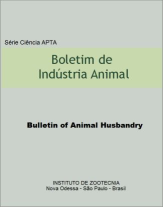Defoliation of marandu grass and effects on leaf area index and number of apical meristems
DOI:
https://doi.org/10.17523/bia.v73n3p212Keywords:
Brachiaria brizantha, canopy height, canopy structure, phenotypic plasticityAbstract
The objective of this study was to understand how the strategy of defoliation prior to deferred grazing modifies the structure of Brachiaria brizantha cv. marandu (marandu grass) at the beginning of deferment. The following three defoliation strategies wer e evaluated: 15/15 cm €“ canopy height of 15 cm in the three months prior to deferment; 30/15 cm €“ canopy height of 30 cm in the preceding three months and defoliation to 15 cm at the beginning of deferment; 45/15 cm €“ canopy height of 45 cm in the three preceding months and defoliation to 15 cm at the beginning of deferment. A complete randomized design with four replications was used. When compared to the 30/15 and 45/15 cm canopies, the 15/15 cm canopy exhibited a larger number of tillers (P<0.0001), especially tillers with apical meristem (P=0.0004), as well as a higher forage mass (P=0.0071), percentage of leaves (P=0.0005), extended plant height (P=0.0304), horizontality index (P=0.011), and remnant leaf area index (P<0.0001) after defoliation to 15 cm. On the other hand, higher canopies (30/15 cm and 45/15 cm) had a greater tiller weight (P=0.0399), percentage of live stems (P<0.0001), dead stems (P=0.0049) and dead leaves (P<0.0077), and leaf litter mass (P=0.0028) after defoliation. The maintenance of marandu grass at 15 cm for three months before deferred grazing promotes an increase in the leaf area index and in the number of tillers with apical meristem in the forage canopy. These characteristics may contribute to increase plant growth during deferred grazin.
Downloads
Downloads
Published
Issue
Section
License
Os autores não serão remunerados pela publicação de trabalhos, pois devem abrir mão de seus direitos autorais em favor deste periódico. Por outro lado, os autores ficam autorizados a publicar seus artigos, simultaneamente, em repositórios da instituição de sua origem, desde que citada a fonte da publicação original seja Boletim de Indústria Animal. A revista se reserva o direito de efetuar, nos originais, alterações de ordem normativa, ortográfica e gramatical, com vistas a manter o padrão culto da língua e a credibilidade do veículo. Respeitará, no entanto, o estilo de escrever dos autores. Alterações, correções ou sugestões de ordem conceitual serão encaminhadas aos autores, quando necessário. Nesses casos, os artigos, depois de adequados, deverão ser submetidos a nova apreciação. As opiniões emitidas pelos autores dos artigos são de sua exclusiva responsabilidade. Todo o conteúdo deste periódico, exceto onde está identificado, está licenciado sob a Licença Creative Commons Attribution (CC-BY-NC). A condição BY implica que os licenciados podem copiar, distribuir, exibir e executar a obra e fazer trabalhos derivados com base em que só se dão o autor ou licenciante os créditos na forma especificada por estes. A cláusula NC significa que os licenciados podem copiar, distribuir, exibir e executar a obra e fazer trabalhos derivados com base apenas para fins não comerciais.













